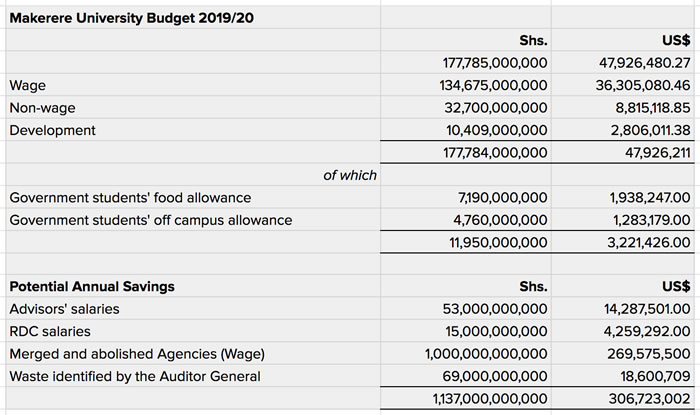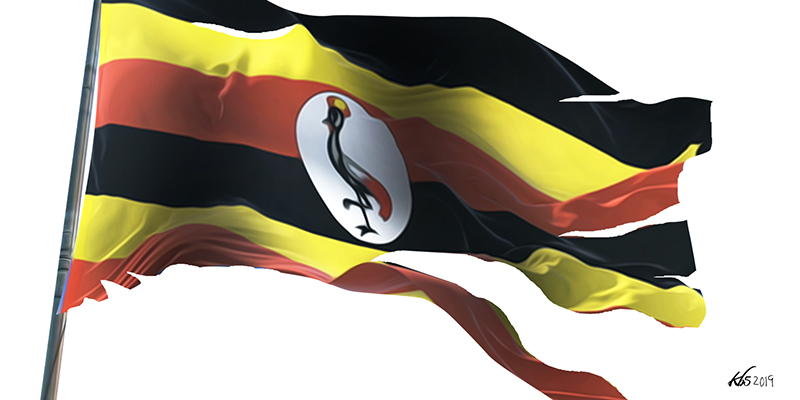During the current lull in strike activity at Makerere University, it is possible to examine the root causes of sporadic strike action on the campus, both by staff and students. The strike was a student protest under the banner #FeesMustFall and was triggered by the proposed 15 per cent annual increase in fees for privately sponsored students (more than half of the student body).
It has been a tense two weeks, with the strike leader, one Siperia Saasirabo, reportedly abducted and held for a number of days, and the Guild President Julius Kateregga disappearing en route from an appearance on a morning television chat show and an extraordinary general meeting of the Guild. Both were reportedly dumped in public places, Kateregga with alleged soft tissue injuries.
An opposition MP told Parliament he was being held in a “safe house” run by the Special Forces Command (SFC) while the minister for higher education stated that he had information that Kateregga was merely taking time out from the pressure he had been undergoing. Kateregga says he made that statement at gunpoint.
The Budget Monitoring and Accountability Unit (BMAU) at the Ministry of Finance summarised the problem at Makerere and other government universities: there simply isn’t enough money to run them. Apart from Makerere and Kyambogo universities, the Government of Uganda has established six other public universities and two degree-awarding institutions. Three came into existence as recently as 2016/17. The major source of funding is tuition fees followed by government/public funding – which includes tuition fees, external grants and internally generated funding. The cost of funding public universities leapt from Shs.167.94 billion ($45,215,553.00) in FY 2012/13 to Shs.606.09 billion ($163,220,340.00) in FY 2017/18. The Ministry of Finance is unequivocal in stating that the government is unable to provide for all the financial needs of public universities and that funds are insufficient to produce “good outputs”. In fact for the last five years, cash releases from the Treasury have been below budget (BMAU Policy Briefing Paper (24/18, 2018).
It is, therefore, safe to conclude that private students subsidise government-sponsored students. This may not have been a problem in principle or in practice if the economy was such that they could afford it. The fact is that most courses charge close to half of Uganda’s income per capita of about $800 or Shs.2,971,608. Assuming parents have more than one child, payment for university education is out of reach for the majority.
The Budget Monitoring and Accountability Unit (BMAU) at the Ministry of Finance summarised the problem at Makerere and other government universities: there simply isn’t enough money to run them.
The major casualties of this are the quality of outcomes, staff development, and research. Because 59 per cent of Makerere’s budget goes towards payroll, and 11 per cent each on student costs and material supplies, less than 2 per cent is available for staff development. Research, a core function of the institution, is allocated under 1 per cent of the government budget (as distinct from external funding). Student welfare allowances can hardly compete and have been stagnant for over two decades. Research received Shs.30 billion ($8,079,015.00) against the expected Shs.50 billion ($13,465,025.00) in 2018/19. As a solution, the BMAU recommends diversification of income streams to reduce over-reliance on tuition fees. In the interim, financial brinksmanship has been the order of the day.
There are 20,091 government-sponsored students at Makerere of whom just over 4,000 are accommodated off-campus. An allowance of Shs.432,750 ($117) a semester was budgeted for each student to cater for their subsistence. The 2019/2020 allowances budget was reduced in order to rehabilitate the dental school whose dilapidated state and consequent interruption of admission of dentistry students made the news in 2017. According to The Observer of 17 July 2019, “285 million was diverted from the allowances vote and allocated to the Dental School. Another Shs.1.8 billion was allocated towards equipping the university library, while Shs.1.5 billion was allocated to the renovation of toilets in the halls of residence.” This was done in compliance with Parliament’s education and social services committee recommendations communicated on 18 June 2019.
During the current strike, there have been calls for Makerere to be managed by people with business skills as opposed to vice-chancellors elected from amongst academics. There is some merit in this argument; Makerere’s history of financial management does not inspire confidence. In 2016 the Auditor General qualified the university’s audit report, citing a number of significant anomalies that suggested sleight of hand in hiding income, debt, and payroll fraud. The report cited the following irregularities:
- The budget itself was undermined by the fact that Shs.317,227,405 ($85,429.00) was charged against incorrect expenditure codes thereby misstating the balances in the financial statements.
- Staff advances for various activities amounting to Shs.882,316,616 ($237,608.00) were not accounted for. “There is uncertainty as to whether the amount in question was properly utilised for the intended purposes.”
- Revenues received from grants and investments were under-reported. Only revenue from 79 out of a total of 182 active grants was disclosed in the financial statements. The university administration also claimed it did not obtain any revenue from investments during the year under review. However its annual report for 2015 puts the cost of running projects from grants at US$50,000,000 in the year 2015. It also says that the university initiated an endowment fund in 2014 called the Makerere University Endowment Fund, whose investment activities and revenues to date have not been disclosed in the financial statements.
- Fourteen retired members of staff were kept on the payroll, costing Shs.386,790 while overpayments to other staff cost a further Shs.172,560,
- 2,494,991,040 ($671,902.00) in revenue was collected from short courses although this amount was not declared in the financial statements.
- Revenue from tuition and functional fees was similarly misstated; the cash book showed 86,816,793,066 ($23,435,802) while the financial statements reported a figure of Shs.87,946,425,729 ($23,740,741.00). The Auditor-General stated: “I was not provided with a satisfactory explanation regarding this discrepancy. Under the circumstances, I am unable to establish the accuracy of the revenue reflected in the financial statements.”
- Emphasis was placed on the under-statement of outstanding obligations. Out of 119,664,797,892 ($32,225,789.00) owed by Makerere by close of the financial year, “only Shs.47,167,283,674 ($12,702,173.00) was recognised in its Statement of Financial position and Statement of Outstanding Commitments, while the remaining Shs. 72,497,514,218 ($19,523,616.00) is only mentioned/disclosed in additional notes.”
The patronage economy
What is missing from the solutions proposed for Makerere by BMAU, such as the diversification of income and rationalisation of courses offered, is the elimination of waste. In addition to reducing waste and financial loss caused by sheer lack of capacity to run the business end of the university, the government needs urgently to address other areas of waste.
Shs.69 billion was lost to systemic waste across all spending entities in 2017/18. Some of the means by which this was achieved are examined here. Structurally, the ballooning number of administrative units – 134 districts and rising from the initial 29 in 1997 – is a huge drain on resources that doesn’t necessarily increase effectiveness (this writer has dealt elsewhere with the phenomenon of districts being unable to utilise funds for lack of skilled manpower). Each new district is entitled to three members of parliament, one a woman and one a youth. District leaders are elected but the president appoints a Resident District Commissioner (RDC) to each. The RDC wage bill is Shs. 15.8 billion ($4,259,292.00), 30 per cent more than Makerere’s annual development budget.
Similarly, ministries, departments and agencies (MDA) increase in number as service delivery becomes ever more inadequate. In 2016, 34 per cent of local governments were found to lack critical staff such as doctors. 116 were understaffed by up to 40 per cent. That year the most affected by understaffing were said to be public universities.
During the current strike, there have been calls for Makerere to be managed by people with business skills as opposed to vice-chancellors elected from amongst academics. There is some merit in this argument; Makerere’s history of financial management does not inspire confidence.
In order to lower the cost of public administration, a major restructuring was agreed by Cabinet in September 2018. Only four agencies (Kampala Capital City Authority, the Uganda Bureau of Statistics, Uganda National Bureau of Standards, and Uganda Communications Commission) and the National Medical Stores were either to be retained and the functions of the rest returned to their parent ministries or to be merged or disbanded. Over one-third of the government payroll is absorbed by the 10,000 employees of agencies, which have tended to duplicate work and serve mainly as sinecures for party apparatchiks. This would have freed up funds currently used for the higher salaries paid to agency executives as well as their pensions and gratuities. Since the announcement a year ago, there has not been a single closure; implementation modalities were reportedly still under review by August 2019. Furthermore, there are more agencies in the pipeline (i.e. the Skills Development Authority and Sector Skills Councils slated for 2021).
The lack of political will to conserve scarce resources is evident in other areas, as a recent review of the cost of political appointees by the Daily Monitor shows. There are now 170 presidential advisors – up from four in the 1990s – whose annual wage bill is Shs.29 billion ($7,817,689.00), with an additional Shs.24 billion ($6,469,812.00) for their ministerial vehicles (without fuel, drivers and guards). Again, the total exceeds Makerere’s research budget. The most recent appointees are musicians appointed to advise on Ghetto and Kampala Affairs. They join the relatively new Ministry for Kampala and the new position of Executive Director of Kampala Capital City Authority, both seen locally as political appointments.

Further savings could have been made by eliminating the Shs.30 billion spent every year on flying dignitaries abroad for medical treatment but they have been cancelled out by the inept procurement of a domestic specialised hospital that has left the country in debt.
The State House scholarships scheme could yield further savings. Under this scheme, students whose primary and/or secondary education has been paid for by the State are often sent overseas for post-graduate studies. Elections expense for the incumbent are another diversion of funds from productive expenditure. As with elections before them, the 2021 polls are being preceded by huge billboards, vinyl banners, cash and other handouts, such as Shs.80 billion ($21,544,040.00) worth of hoes for distribution – all paid for from the public purse. (Ugandan farmers clamour for much – seeds, fertilisers, herbicides, irrigation, information, advice, post-harvest technologies, feeder roads and access to markets – but there has been no shortage of hoes since the post-war period.)
The lack of political will to conserve scarce resources is evident in other areas, as a recent review of the cost of political appointees by the Daily Monitor shows. There are now 170 presidential advisors – up from four in the 1990s – whose annual wage bill is Shs.29 billion ($7,817,689.00)…
The unrest at Makerere is the fruit of the wider patronage economy and its untenable strictures. Public financial mismanagement and fraud lead to unforeseen and unnecessary austerity being visited on various sections of the community, including hospital patients, primary school children, farmers, road users etc. University students are in the best position to highlight this systemic injustice because unlike the general population at the receiving end of governance deficits, they are a homogenous group able to agree on a way forward, and the best equipped to analyse the issues. Striking Makerereans speak for all Ugandans.
State brutality
As is the norm, what began as a peaceful demonstration with perhaps a dozen women carrying placards immediately attracted the full retribution of the Uganda People’s Defence Forces, which had been camping on campus since late 2018 when the People Power movement gained national prominence. True to form, the method of work is to instill terror by attacking not only striking students but also firing tear gas canisters into the closed windows of halls of residence and hostels. There were night raids in which students were dragged out of their rooms, brutalised and their property vandalised. The partially sighted and deaf were not spared and their press conference was stopped by the Uganda Police, a de facto division of the army.
Initial reports on the night of 22nd October were from citizen journalists. The professional media was largely absent (which is understandable given recent threats of shut-downs to those covering “opposition” activities). Of those journalists that did attend, at least three have been hospitalised with injuries and a similar number have been arrested.
The most valiant efforts of government sympathisers to demoralise the students on chat shows and social media by branding them drug abusers were unable to stigmatise the students as “entitled” young people making a nuisance of themselves. Also new, a journalist accused of biased reporting (not for the first time) was heckled off campus by irate students.
The Uganda Journalist’s Association is boycotting all police pressers and other events, this time asking media house heads to join them, a major development in protest. Still, the repeated night raids amply demonstrated the extremes to which Uganda’s kleptocracy is willing to go to preserve itself. Student leaders continue to be suspended as they are identified. The police is visible everywhere on campus and Lumumba Hall was completely sealed off at the time of writing. The army is to be replaced on campus by 2,000 police officers.
If the military was predictable so was the president, his ministers and the diplomatic corps to whom Ugandans appeal during spates of state brutality. After the usual interval of a few days, the United States ambassador played her customary role, publicly expressing concern for the affront to freedoms of assembly, speech and expression guaranteed by Uganda’s constitution. After a further few days during which the public was fully appraised of his impunity, President Yoweri Museveni, the Commander-in-Chief, withdrew the army from the university, stating that he was unaware they were camped there (for a year) in the first place. He faulted the military approach to addressing the issue, saying the young people only needed guidance.
Initial reports on the night of 22nd October were from citizen journalists. The professional media was largely absent (which is understandable given recent threats of shut-downs to those covering “opposition” activities). Of those journalists that did attend, at least three have been hospitalised with injuries and a similar number have been arrested.
France’s ambassador remained focused on cementing relations with Gen. Kainerugaba, the president’s son who is responsible for the SFC, safe houses, #Arua33 and other atrocities. He hosted him at his residence at the height of the troubles. A French company is in negotiations for an oil concession. The European Union and other European members of the diplomatic corps then weighed in, saying much the same as the Americans, only to be contradicted hours later by the Minister for Security, General Tumwine, who advised students that strikers would be beaten and to ignore statements to the contrary.
The latest developments are that Gulu University’s peaceful march in solidarity with Makerere was intercepted by police and four students were arrested for the public order offences of illegal assembly and incitement to violence.
The Minister of Education and First Lady has not appeared before Parliament to make a statement on the unrest. Instead she wrote a long letter to “the children who call me Mama by choice” in which she compared Makerere’s fees with the higher fees charged by a private university. She then claimed that the strikers were mainly non-students hired to riot: “Next time you are tempted to point a finger at corrupt people, if you are guilty of any of the above, know that you too are corrupt; begin with yourself.” The minister finished with an elaborate exegesis of the Scriptures on the origin of authority and why we must submit to it.







